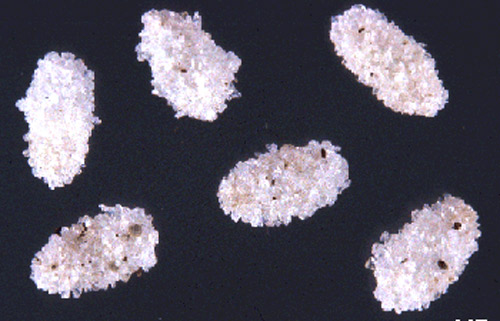 |
| The Fleas that Ate Florida- Coming to Theater Soon! |
Florida always stands out. Whether it’s in the news, during elections, or just on a map, even those who are not fortunate enough to live in our great state know that Florida is unique. Pet owners become even more aware of Florida’s specialness in January and February, when we have our yearly winter flea resurgence. Few other states are “lucky” enough to have a second flea season.
Fleas are black insects slightly bigger than a sesame seed, which can’t fly, but can run and jump very quickly. They bite and suck blood, and a single female can lay 2000 eggs over the few weeks she is alive. The flea eggs hatch into small worms called larvae, which then form cocoons, called pupae, and mature into adult fleas.
 |
| Flea eggs and larva. Photo from University of Florida |
 |
| Flea Pupae- little flea cocoons. Picture from University of Florida |
North of us, the flea population dies down with winter temperatures. Outside temperatures of less then 32 degrees (freezing) for more than 72 continuous hours can kill fleas, flea eggs and larva. Unfortunately for us, the “thin blood” that causes many Floridians to wear heavy coats when the temperature drops to the 50’s, doesn’t apply to those pesky jumping bloodsuckers, so the flea scourge continues unabated. Combine that with increased wildlife activity from all that fruit your neighbor left on their tree and we often see more fleas in January and February than mid summer.
Pet owners who have dogs itching around the base of the tail, or cats with small pin-prick scabs around the neck and base of the tail, should always consider fleas, even if you are not seeing the little critters crawling around. With people, we would never doubt that someone was bitten by a bee because they don’t have an actual bee on them at that moment. Similarly, dogs and cats may itch at a flea bite long after the flea has jumped, or been scratched, off the pet. Some dogs and cats are especially allergic to flea bites, and a single bite can cause them to scratch themselves until they are bleeding.
 |
| Classic Flea Allergy Bald-Behind |
 |
| Severe Flea Allergy |
One tell-tale sign of fleas is “flea dirt.” These little black comma or dot shaped specks are the feces of feeding fleas, and can be distinguished from plain dirt because they turn red when placed on a wet paper towel or tissue. The red is the digested blood meal the flea has taken from a pet (or a person.) Even if you never see a flea, seeing flea dirt means fleas have been present recently.
 |
| A whole bunch of flea dirt on a dog. Photo by Gary Alpert, Harvard |
Years ago, we were stuck with sprays and dips to remove fleas, which were a temporary help at best. Sprays for the house and yard still help, but you should use sprays that contain an IGR, or insect growth regulator. IGR prevent flea eggs from hatching, and the pupae from maturing, and are much more effective than adult-flea killing sprays.
Modern flea medications for pets, either topical or oral, have been a huge help. Many pet owners have reported some of the “older” topical medications (such as Advantage, Frontline, or the Frontline generics like Pet Armor Plus) as being less effective than in past years. Fortunately there are many other choices available; at the time of this article, we've found Comfortis and Activyl to be very useful. It does seem that different things work for different people, so talk to your veterinarian about your options.
We all love sending winter pictures of us at the beach, or dressed in shorts, up to our northern friends and relatives, who are grumbling bundling up and shoveling snow. Unfortunately, the blessing of warm winters comes with several costs, and winter fleas are one of the irritating ones for our four legged friends. Be vigilant; Tampa Bay never gets too cold for fleas.



